The Development Simulation of Urban Green Space System Layout Based on the Land Use Scenario: A Case Study of Xuchang City, China
Abstract
1. Introduction
2. Materials and Methods
2.1. Study Area
2.2. Study Method
2.2.1. Land Use Layout Simulation
2.2.2. Evaluation of the Simulation Scenarios
2.3. Data Basis and Preprocessing
2.3.1. Data Sources
2.3.2. Parameter Settings
Parameter Identification of Spatial Driving Factors
Restrictions on Space Development
Relevant Planning Polices and Index Constraints
Model Parameter Settings
3. Results and Analysis
3.1. Scenario Simulation of Land Use Layout
3.2. Analysis of Simulation Results
4. Discussion
- (1)
- Model parameters setting. In addition to spatial location influencing factors, driving factors, such as economy and population, could be added as well as time variation and spatial differentiation of planning policies and constraint indicators [77]. While considering the protection of ecological space and the accessibility of green spaces, the connectivity of green space also could be taken as an important variable to optimize the layout from the perspective of biodiversity [78,79,80]. In addition, this study also tested the parameter combination of self-adaptive inertia and the competition mechanism of the CA module to obtain an optimal combination. It should combine planning rules to improve the accuracy of the simulation results.
- (2)
- Research object level. According to the latest Standard for classification of urban green space (CJJ/T85-2017) [60], this research can be extended to examine the relationship between regional green space and urban construction land development, as well as the external correlation and agglomeration effect of various green space types within urban construction land. In addition, the layout optimization, as well as intensive and efficient development of urban land should be discussed at multiple levels and scales [81,82].
- (3)
- Planning rigidity and flexibility. The requirements of land use properties and development intensity of various types of urban land are dynamic. The control indicators based on the land plot are too rigid to respond in a timely fashion to the future development scenario of the city. Thus, the planning of “blank” and elastic spaces should be considered to better connect the planning system [83,84].
5. Conclusions
Author Contributions
Funding
Acknowledgments
Conflicts of Interest
References
- Lu, Y.; Wang, R.; Zhang, Y.; Su, H.; Wang, P.; Jenkins, A.; Ferrier, R.C.; Bailey, M.; Squire, G. Ecosystem health towards sustainability. Ecosyst. Heal. Sustain. 2015, 1, 1–15. [Google Scholar] [CrossRef]
- Southon, G.E.; Jorgensen, A.; Dunnett, N.; Hoyle, H.; Evans, K.L. Perceived species-richness in urban green spaces: Cues, accuracy and well-being impacts. Landsc. Urban Plan. 2018, 172, 1–10. [Google Scholar] [CrossRef]
- Wang, Y.C.; Shen, J.K.; Xiang, W.N. Ecosystem service of green infrastructure for adaptation to urban growth: Function and configuration. Ecosyst. Heal. Sustain. 2018, 4, 132–143. [Google Scholar] [CrossRef]
- Verdú-Vázquez, A.; Fernández-Pablos, E.; Lozano-Diez, R.V.; López-Zaldívar, Ó. Development of a methodology for the characterization of urban and periurban green spaces in the context of supra-municipal sustainability strategies. Land Use Policy 2017, 69, 75–84. [Google Scholar] [CrossRef]
- Long, Y.; Gu, Y.; Han, H. Spatiotemporal heterogeneity of urban planning implementation effectiveness: Evidence from five urban master plans of Beijing. Landsc. Urban Plan. 2012, 108, 103–111. [Google Scholar] [CrossRef]
- Haaland, C.; van den Bosch, C.K. Challenges and strategies for urban green-space planning in cities undergoing densification: A review. Urban For. Urban Green. 2015, 14, 760–771. [Google Scholar] [CrossRef]
- Baycan-Levent, T.; Nijjkamp, P. Planning and management of urban green spaces in Europe: Comparative analysis. J. Urban Plan. Dev. 2009, 135, 1–12. [Google Scholar] [CrossRef]
- Tiba, C.; Candeias, A.L.B.; Fraidenraich, N.; Barbosa, E.M.d.S.; de Carvalho Neto, P.B.; de Melo Filho, J.B. A GIS-based decision support tool for renewable energy management and planning in semi-arid rural environments of northeast of Brazil. Renew. Energy 2010, 35, 2921–2932. [Google Scholar] [CrossRef]
- Hopkins, L. Book Review: Planning support systems for cities and regions. Int. J. Geogr. Inf. Sci. 2011, 25, 324–325. [Google Scholar] [CrossRef]
- Cerreta, M.; De Toro, P. Urbanization suitability maps: A dynamic spatial decision support system for sustainable land use. Earth Syst. Dyn. 2012, 3, 157–171. [Google Scholar] [CrossRef]
- Jin, Y.; Liu, S.; Li, R.; Liu, Y. Urban Green Space System Planning Formulation—Research on “Subsystem” Planning Method. Chin. Landsc. Archit. 2013, 29, 56–59. [Google Scholar]
- Xu, C.; Haase, D.; Pribadi, D.O.; Pauleit, S. Spatial variation of green space equity and its relation with urban dynamics: A case study in the region of Munich. Ecol. Indic. 2018, 93, 512–523. [Google Scholar] [CrossRef]
- Zhang, Y.; Feng, G. Study on dynamic land use planning. China Land. Sci. 2017, 31, 25–32. [Google Scholar]
- Batty, M. The size, scale, and shape of cities. Science. 2008, 319, 769–771. [Google Scholar] [CrossRef]
- Spencer, D. Cities and Complexity: Understanding Cities with Cellular Automata, Agent-Based Models, and Fractals. J. Archit. 2009, 14, 446–450. [Google Scholar] [CrossRef]
- Xiang, W.N.; Clarke, K.C. The use of scenarios in land-use planning. Environ. Plan. B Plan. Des. 2003, 30, 885–909. [Google Scholar] [CrossRef]
- Sohl, T.L.; Sleeter, B.M.; Sayler, K.L.; Bouchard, M.A.; Reker, R.R.; Bennett, S.L.; Sleeter, R.R.; Kanengieter, R.L.; Zhu, Z. Spatially explicit land-use and land-cover scenarios for the Great Plains of the United States. Agric. Ecosyst. Environ. 2012, 153, 1–15. [Google Scholar] [CrossRef]
- Liu, J.; Zhang, L.; Ji, Y.; Zhang, Q. Spatial-temporal Evolution Analysis of Urban Green Space System Based on Fractal Model: A Case Study of Downtown Shanghai. Mod. Urban Res. 2019, 12–19. [Google Scholar]
- Liu, Y.; Wang, J. Theoretical analysis and technical methods of “multiple planning integration” in the rural to urban transition period in China. Prog. Geogr. 2016, 35, 529–536. [Google Scholar]
- Liu, Y.; Fang, F.; Li, Y. Key issues of land use in China and implications for policy making. Land Use Policy 2014, 40, 6–12. [Google Scholar] [CrossRef]
- Batty, M.; Xie, Y. From cells to cities. Environ. Plan. B Plan. Des. 1994, 21, 531–548. [Google Scholar] [CrossRef]
- Yeh, A.G.O.; Li, X. Errors and uncertainties in urban cellular automata. Comput. Environ. Urban Syst. 2006, 30, 10–28. [Google Scholar] [CrossRef]
- Hamad, R.; Balzter, H.; Kolo, K. Predicting land use/land cover changes using a CA-Markov model under two different scenarios. Sustainable 2018, 10, 3421. [Google Scholar] [CrossRef]
- Li, X.; Yeh, A.G. Modelling sustainable urban development by the integration of constrained cellular automata and GIS. Int. J. Geogr. Inf. Sci. 2010, 14, 37–41. [Google Scholar] [CrossRef]
- Wickramasuriya, R.C.; Bregt, A.K.; van Delden, H.; Hagen-Zanker, A. The dynamics of shifting cultivation captured in an extended Constrained Cellular Automata land use model. Ecol. Modell. 2009, 220, 2302–2309. [Google Scholar] [CrossRef]
- White, R.; Engelen, G.; Uljee, I. The use of constrained cellular automata for high-resolution modelling of urban land-use dynamics. Environ. Plan. B Plan. Des. 1997, 24, 323–343. [Google Scholar] [CrossRef]
- Li, X.; Ye, J. Constrained Cellular Automata for modelling sustainable urban Forms. Acta Geogr. Sin. 1999, 54, 289–298. [Google Scholar]
- Zhang, Y.; Li, X.; Liu, X.; Qiao, J. Self-modifying CA model using dual ensemble Kalman filter for simulating urban land-use changes. Int. J. Geogr. Inf. Sci. 2015, 29, 1612–1631. [Google Scholar] [CrossRef]
- Liu, X.; Liang, X.; Li, X.; Xu, X.; Ou, J.; Chen, Y.; Li, S.; Wang, S.; Pei, F. A future land use simulation model (FLUS) for simulating multiple land use scenarios by coupling human and natural effects. Landsc. Urban Plan. 2017, 168, 94–116. [Google Scholar] [CrossRef]
- Liang, X.; Liu, X.; Li, X.; Chen, Y.; Tian, H.; Yao, Y. Delineating multi-scenario urban growth boundaries with a CA-based FLUS model and morphological method. Landsc. Urban Plan. 2018, 177, 47–63. [Google Scholar] [CrossRef]
- Chen, Y.; Li, X.; Liu, X.; Ai, B.; Li, S. Capturing the varying effects of driving forces over time for the simulation of urban growth by using survival analysis and cellular automata. Landsc. Urban Plan. 2016, 152, 59–71. [Google Scholar] [CrossRef]
- Wu, F. A linguistic cellular automata simulation approach for sustainable land development in a fast growing region. Comput. Environ. Urban Syst. 1996, 20, 367–387. [Google Scholar] [CrossRef]
- Itami, R.M. Simulating spatial dynamics: Cellular automata theory. Landsc. Urban Plan. 1994, 30, 27–47. [Google Scholar] [CrossRef]
- Zhou, C.; Sun, Z.; Xie, Y. Geographical Cellular Automata; Science Press: Beijing, China, 1999. [Google Scholar]
- Islam, K.; Rahman, M.F.; Jashimuddin, M. Modeling land use change using Cellular Automata and Artificial Neural Network: The case of Chunati Wildlife Sanctuary, Bangladesh. Ecol. Indic. 2018, 88, 439–453. [Google Scholar] [CrossRef]
- Huang, D.; Huang, J.; Liu, T. Delimiting urban growth boundaries using the CLUE-S model with village administrative boundaries. Land Use Policy 2019, 82, 422–435. [Google Scholar] [CrossRef]
- Li, X.; Li, D.; Liu, X.; He, J. Geographical Simulation and Optimization System(GeoSOS) and Its Cutting-edge Researches. Adv. Earth Sci. 2009, 24, 899–907. [Google Scholar]
- Liang, X.; Liu, X.; Li, D.; Zhao, H.; Chen, G. Urban growth simulation by incorporating planning policies into a CA-based future land-use simulation model. Int. J. Geogr. Inf. Sci. 2018, 32, 2294–2316. [Google Scholar] [CrossRef]
- Lu, L.; Weng, Q.; Guo, H.; Feng, S.; Li, Q. Assessment of urban environmental change using multi-source remote sensing time series (2000–2016): A comparative analysis in selected megacities in Eurasia. Sci. Total Environ. 2019, 684, 567–577. [Google Scholar] [CrossRef]
- Stone, B.; Hess, J.J.; Frumkin, H. Urban form and extreme heat events: Are sprawling cities more vulnerable to climate change than compact cities? Environ. Health Perspect. 2010, 118, 1425–1428. [Google Scholar] [CrossRef]
- Howard, E. Garden Cities of To-morrow; MIT Press: Massachusetts, MA, USA, 1965. [Google Scholar]
- Lindley, S.; Pauleit, S.; Yeshitela, K.; Cilliers, S.; Shackleton, C. Rethinking urban green infrastructure and ecosystem services from the perspective of sub-Saharan African cities. Landsc. Urban Plan. 2018, 180, 328–338. [Google Scholar] [CrossRef]
- Ramyar, R.; Saeedi, S.; Bryant, M.; Davatgar, A.; Mortaz Hedjri, G. Ecosystem services mapping for green infrastructure planning–The case of Tehran. Sci. Total Environ. 2019, 135466, (Online). [Google Scholar] [CrossRef]
- Qu, C.; Meng, Q. Study on functional zoning of land use in Xuchang City. China L. Sci. 2008, 22, 51–55. [Google Scholar]
- Wu, G.; Yin, X.; Shen, H. Study on land use/land cover changes in Xuchang City based on GIS. Res. Soil Water Conserv. 2009, 16, 131–134. [Google Scholar]
- Belmeziti, A.; Cherqui, F.; Kaufmann, B. Improving the multi-functionality of urban green spaces: Relations between components of green spaces and urban services. Sustain. Cities Soc. 2018, 43, 1–10. [Google Scholar] [CrossRef]
- Lynch, A.J. Is it good to be green? Assessing the ecological results of county green infrastructure planning. J. Plan. Educ. Res. 2016, 36, 90–104. [Google Scholar] [CrossRef]
- Li, X.; Yeh, A.G.O. Neural-network-based cellular automata for simulating multiple land use changes using GIS. Int. J. Geogr. Inf. Sci. 2002, 16, 323–343. [Google Scholar] [CrossRef]
- Almeida, C.M.; Gleriani, J.M.; Castejon, E.F.; Soares-Filho, B.S. Using neural networks and cellular automata for modelling intra-urban land-use dynamics. Int. J. Geogr. Inf. Sci. 2008, 22, 943–963. [Google Scholar] [CrossRef]
- Openshaw, S. Neural network, genetic, and fuzzy logic models of spatial interaction. Environ. Plan. A 1998, 30, 1857–1872. [Google Scholar] [CrossRef]
- Aerts, J.C.J.H.; Heuvelink, G.B.M. Using simulated annealing for resource allocation. Int. J. Geogr. Inf. Sci. 2002, 16, 571–587. [Google Scholar] [CrossRef]
- Huang, K.; Liu, X.; Li, X.; Liang, J.; He, S. An improved artificial immune system for seeking the Pareto front of land-use allocation problem in large areas. Int. J. Geogr. Inf. Sci. 2013, 27, 922–946. [Google Scholar] [CrossRef]
- McGarigal, K.; Marks, B.J. FRAGSTATS: Spatial Patten Anaylsis Program for Quantifyling Landscape Structure; US Forest Service Pacific Northwest Research Station: Portland, Oregon, 1994.
- Yang, X.; Zheng, X.Q.; Chen, R. A land use change model: Integrating landscape pattern indexes and Markov-CA. Ecol. Modell. 2014, 283, 1–7. [Google Scholar] [CrossRef]
- Xing, H.; Meng, Y. Measuring urban landscapes for urban function classification using spatial metricsing spatial metrics. Ecol. Indic. 2020, 108. [Google Scholar] [CrossRef]
- Wu, J. Landscape Ecology: Pattern, Process, Scale and Hierarchy; Higher Education Press: Beijing, China, 1974. [Google Scholar]
- Tian, G.; Ouyang, Y.; Quan, Q.; Wu, J. Simulating spatiotemporal dynamics of urbanization with multi-agent systems-A case study of the Phoenix metropolitan region, USA. Ecol. Modell. 2011, 222, 1129–1138. [Google Scholar] [CrossRef]
- AQSIQ. Current Land Use Classification; General Administration of Quality Supervision, Inspection and Quarantine of the People’s Republic of China/Standardization Administration: Beijing, China, 2017. [Google Scholar]
- MOHURD. Code for Classification of Urban Land Use and Planning Standards of Development Land; Ministry of Housing and Urban-Rural Development of the People’s Republic of China (MOHURD): Beijing, China, 2011.
- MOHURD. Standard for Classification of Urban Green Space; Ministry of Housing and Urban-Rural Development of the People’s Republic of China (MOHURD): Beijing, China, 2017.
- MOHURD. Technical Code for Delineation of Urban Green Line; Ministry of Housing and Urban- Rural Development of the People’s Republic of China (MOHURD): Beijing, China, 2016.
- Chen, S.; Yang, Z.; Wang, Z. “Grey Land” planning: A flexible control method to coordinate short-term and long-term land use of atrophic urban fringe. Urban Dev. Stud. 2016, 2016, 70–77. [Google Scholar]
- Yang, Z.; Wang, Z. Research on flexible control method of land use in new town planning: A case study of Hangzhou Bay New Town. City Plan. Rev. 2014, 38, 43–49, 58. [Google Scholar]
- Santé, I.; García, A.M.; Miranda, D.; Crecente, R. Cellular automata models for the simulation of real-world urban processes: A review and analysis. Landsc. Urban Plan. 2010, 96, 108–122. [Google Scholar] [CrossRef]
- Zhou, T.; Guo, D. GIS-based researches on urban green space on landscape gravity field with Ningbo city as an example. Acta Ecol. Sin. 2004, 24, 1157–1163. [Google Scholar]
- Siewwuttanagul, S.; Inohae, T.; Mishima, N. An investigation of Urban Gravity to develop a better understanding of the urbanization phenomenon using centrality analysis on GIS platform. Procedia Environ. Sci. 2016, 36, 191–198. [Google Scholar] [CrossRef]
- Dahal, K.R.; Chow, T.E. Characterization of neighborhood sensitivity of an irregular cellular automata model of urban growth. Int. J. Geogr. Inf. Sci. 2015, 29, 475–497. [Google Scholar] [CrossRef]
- Brail, R.K. Planning Support Systems for Cities and Regions; Lincoln Institute of Land Policy: Cambridge, MA, USA, 2008. [Google Scholar]
- Zhang, Y.; Li, X.; Liu, X.; Qiao, J.; He, Z. Urban expansion simulation by coupling remote sensing observations and cellular automata. Yaogan Xuebao/J. Remote Sens. 2013, 17, 872–886. [Google Scholar]
- Al-Ahmadi, K.; Heppenstall, A.; Hogg, J.; See, L. A Fuzzy Cellular Automata Urban Growth Model (FCAUGM) for the City of Riyadh, Saudi Arabia. Part 1: Model Structure and Validation. Appl. Spat. Anal. Policy 2009, 2, 65–83. [Google Scholar] [CrossRef]
- Wang, Y.; Shen, J.; Yan, W.; Chen, C. Backcasting approach with multi-scenario simulation for assessing effects of land use policy using GeoSOS-FLUS software. MethodsX 2019, 6, 1384–1397. [Google Scholar] [CrossRef] [PubMed]
- Lin, B.; Meyers, J.; Barnett, G. Understanding the potential loss and inequities of green space distribution with urban densification. Urban For. Urban Green. 2015, 14, 952–958. [Google Scholar] [CrossRef]
- Liao, J.; Shao, G.; Wang, C.; Tang, L.; Huang, Q.; Qiu, Q. Urban sprawl scenario simulations based on cellular automata and ordered weighted averaging ecological constraints. Ecol. Indic. 2019, 107, 1–16. [Google Scholar] [CrossRef]
- Kaufman, L. Nature’s Services: Societal Dependence On Natural Ecosystems; Island Press: Washington, DC, USA, 1997. [Google Scholar]
- Mainka, S.A.; McNeely, J.A.; Jackson, W.J. Depending on Nature: Ecosystem Services for Human Livelihoods. Environ. Sci. Policy Sustain. Dev. 2008, 50, 42–56. [Google Scholar] [CrossRef]
- Abrantes, P.; Rocha, J.; Marques da Costa, E.; Gomes, E.; Morgado, P.; Costa, N. Modelling urban form: A multidimensional typology of urban occupation for spatial analysis. Environ. Plan. B Urban Anal. City Sci. 2019, 46, 47–65. [Google Scholar] [CrossRef]
- Wu, Y.; Zhang, X.; Shen, L. The impact of urbanization policy on land use change: A scenario analysis. Cities 2011, 28, 147–159. [Google Scholar] [CrossRef]
- Carlier, J.; Moran, J. Landscape typology and ecological connectivity assessment to inform Greenway design. Sci. Total Environ. 2019, 651, 3241–3252. [Google Scholar] [CrossRef]
- Matos, C.; Petrovan, S.O.; Wheeler, P.M.; Ward, A.I. Landscape connectivity and spatial prioritization in an urbanising world: A network analysis approach for a threatened amphibian. Biol. Conserv. 2019, 237, 238–247. [Google Scholar] [CrossRef]
- Zhang, Z.; Meerow, S.; Newell, J.P.; Lindquist, M. Enhancing landscape connectivity through multifunctional green infrastructure corridor modeling and design. Urban For. Urban Green. 2019, 38, 305–317. [Google Scholar] [CrossRef]
- Xu, C.; Haase, D.; Pauleit, S. The impact of different urban dynamics on green space availability: A multiple scenario modeling approach for the region of Munich, Germany. Ecol. Indic. 2018, 93, 1–12. [Google Scholar] [CrossRef]
- Sang, L.; Zhang, C.; Yang, J.; Zhu, D.; Yun, W. Simulation of land use spatial pattern of towns and villages based on CA-Markov model. Math. Comput. Model. 2011, 54, 938–943. [Google Scholar] [CrossRef]
- Wallace, M. Flexible planning: A Key to the management of multiple innovations. Educ. Manag. Adm. Leadersh. 1991, 19, 180–192. [Google Scholar] [CrossRef]
- David, L. Land Use Controls: Present Problems and Future Reform; Center for Urban Policy Research, Rutgers University: New Brunswick, NJ, USA, 1974. [Google Scholar]
- Guo, X.; Chang, Q.; Liu, X.; Bao, H.; Zhang, Y.; Tu, X.; Zhu, C.; Lv, C.; Zhang, Y. Multi-dimensional eco-land classification and management for implementing the ecological redline policy in China. Land Use Policy 2018, 74, 15–31. [Google Scholar] [CrossRef]
- Hongqi, Z.; Erqi, X.; Huiyi, Z. Ecological-Living-Productive Land Classification System in China. J. Resour. Ecol. 2017, 8, 121–128. [Google Scholar] [CrossRef]
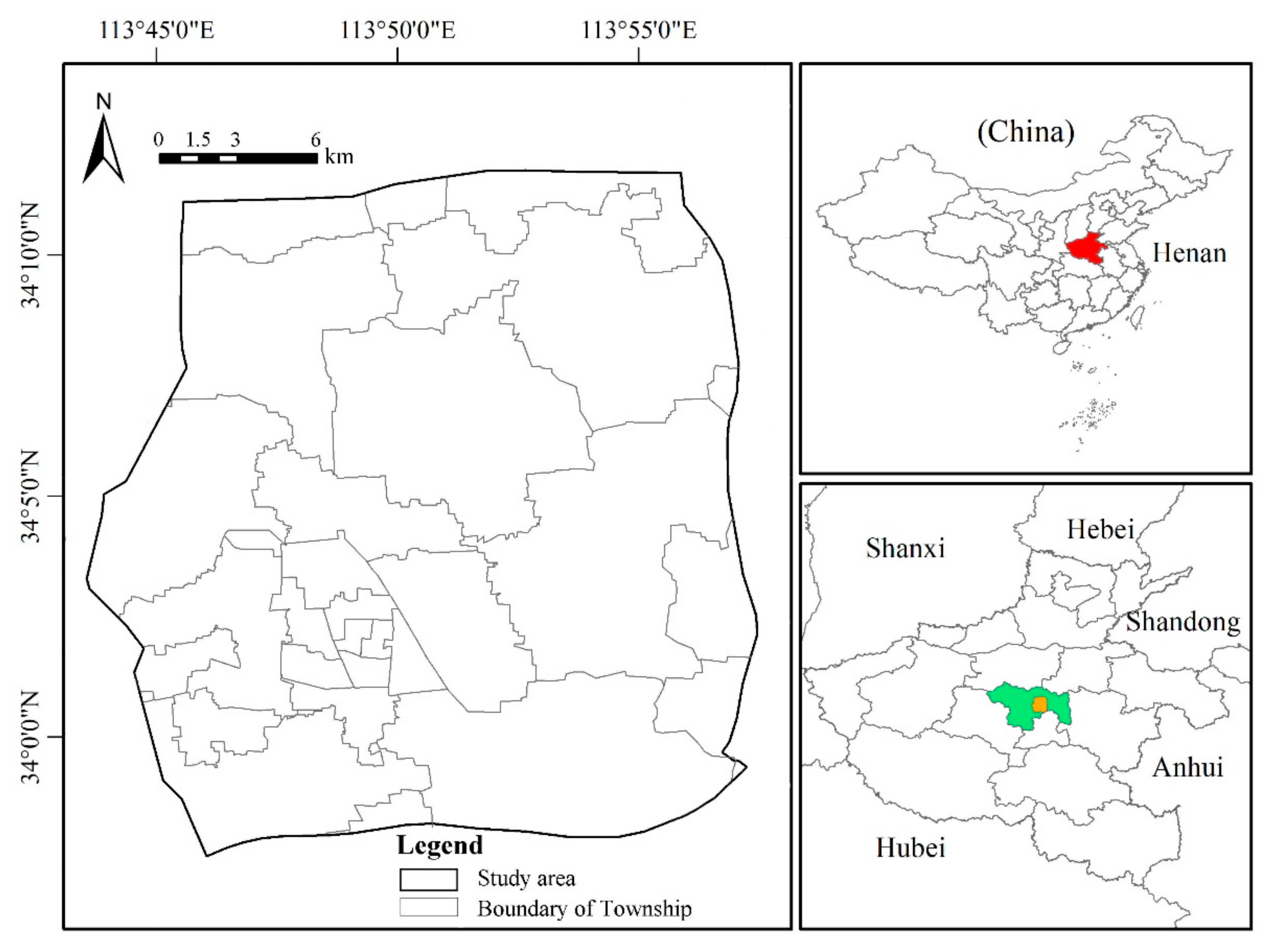
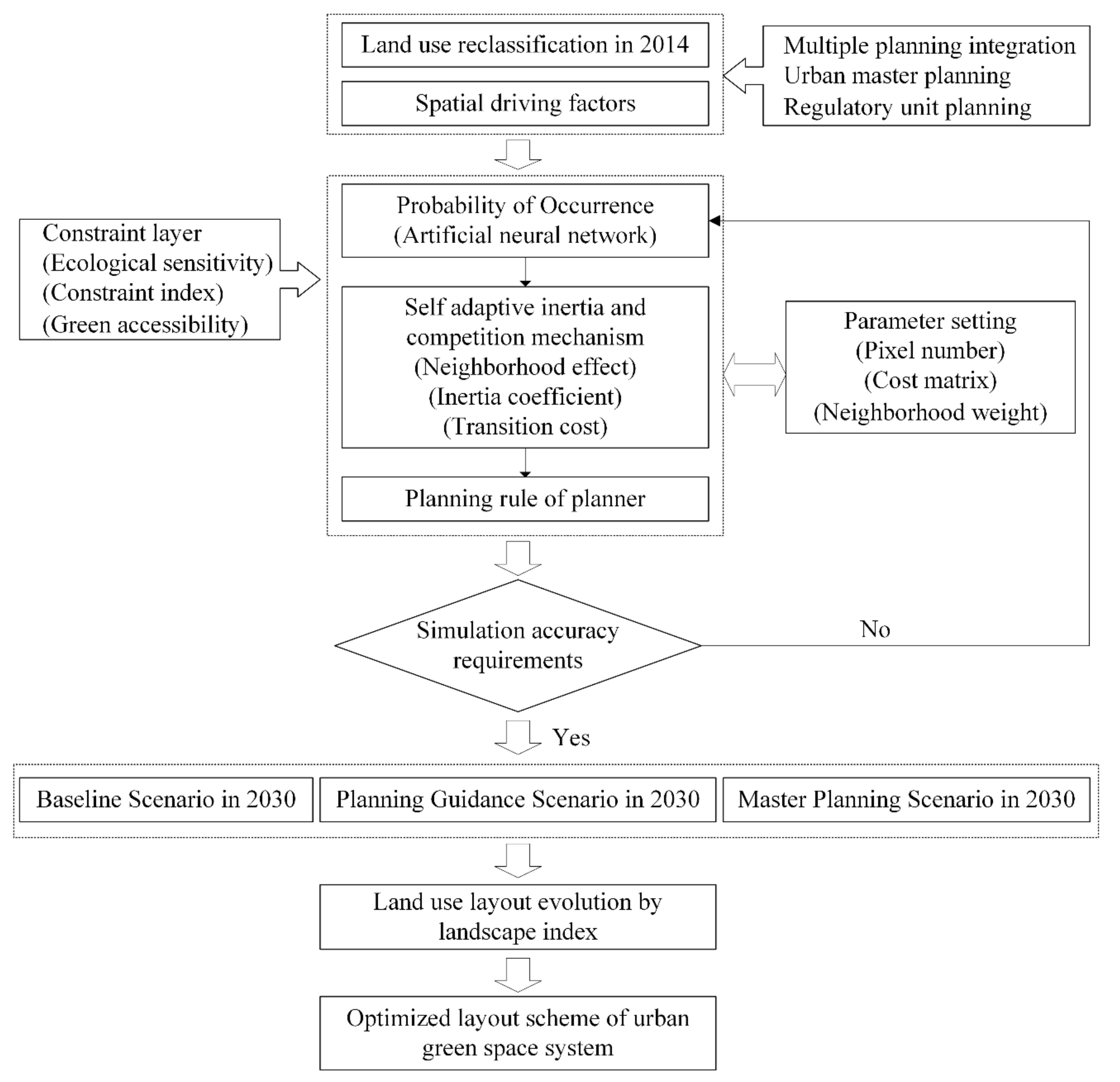
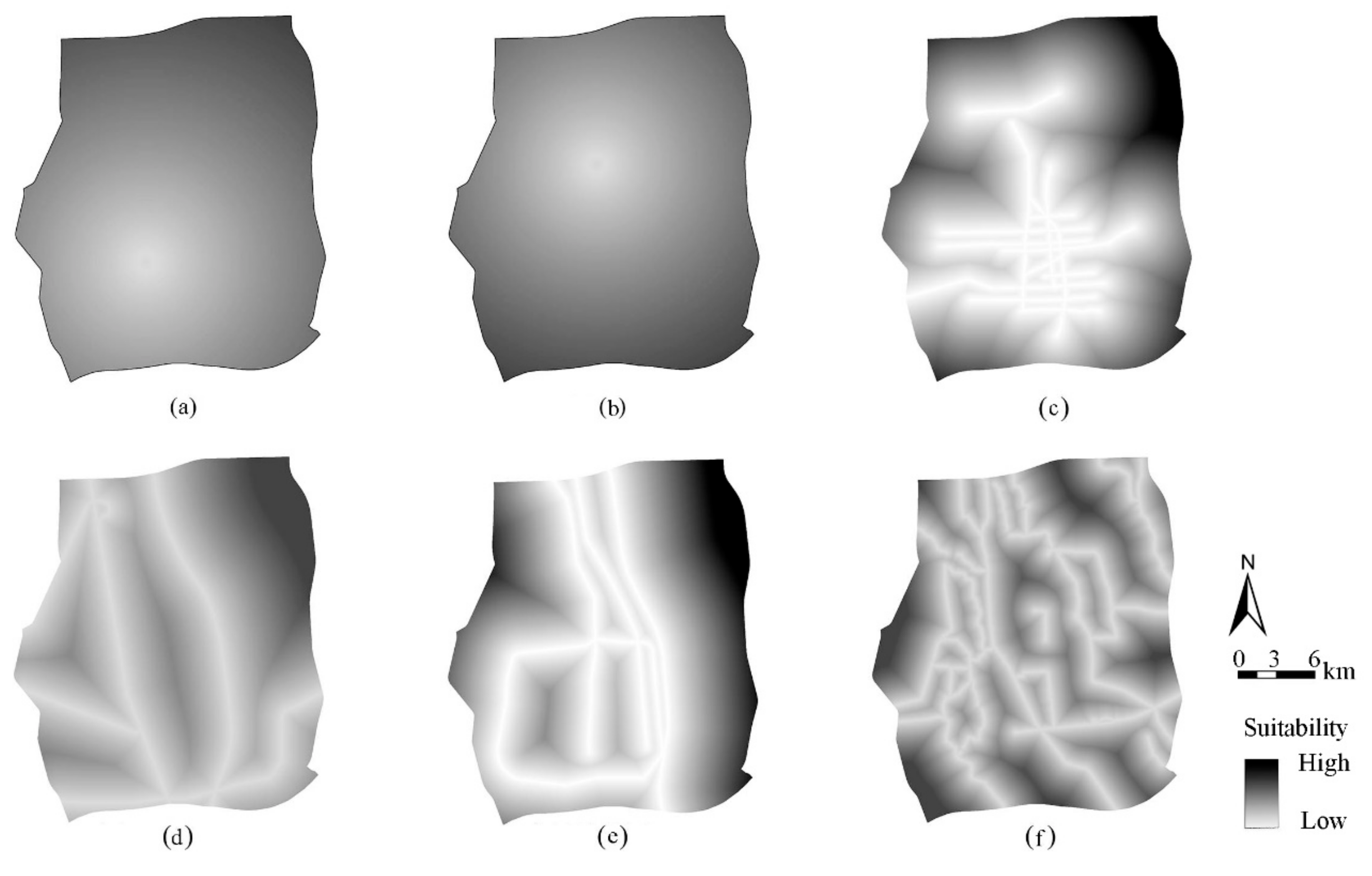
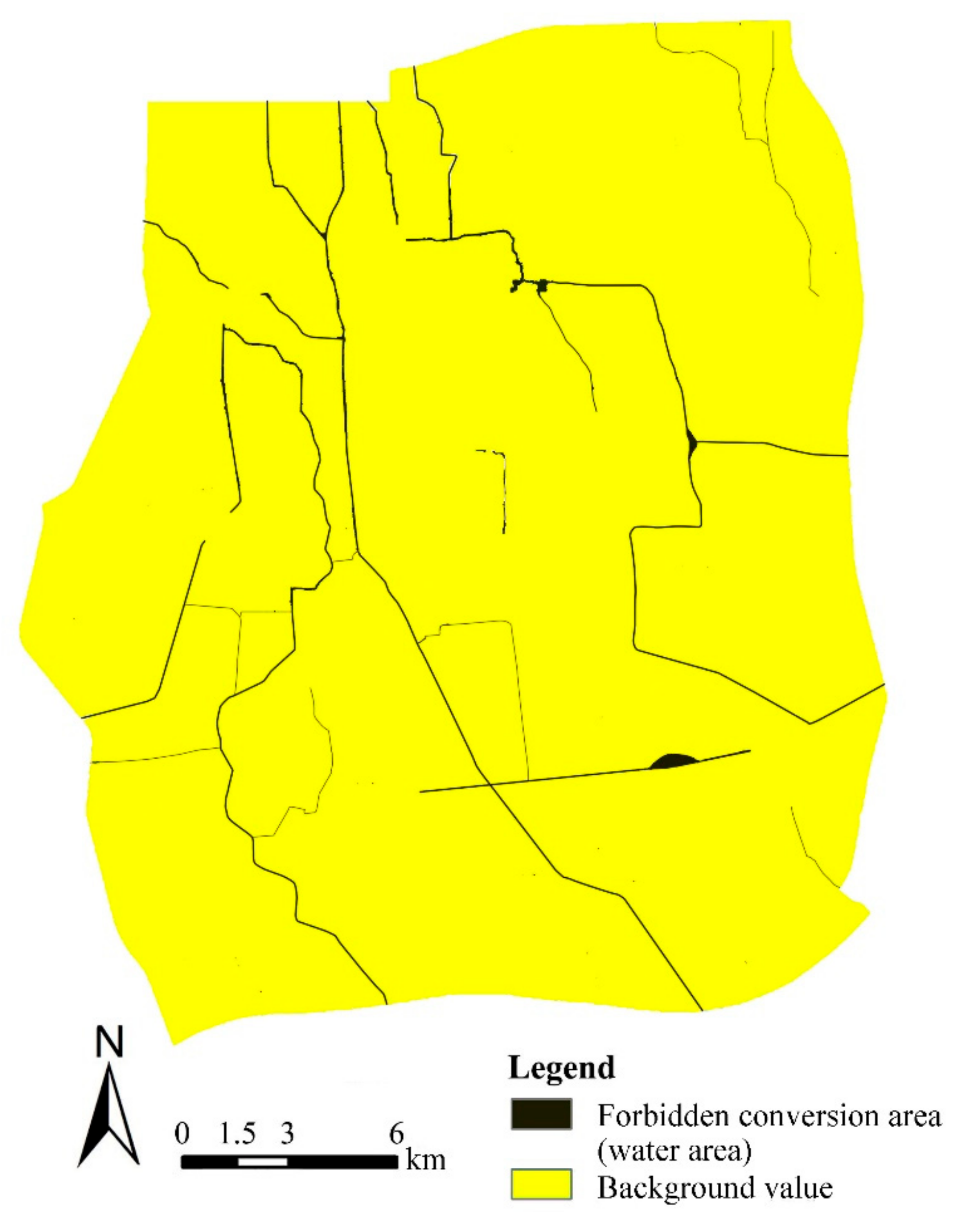
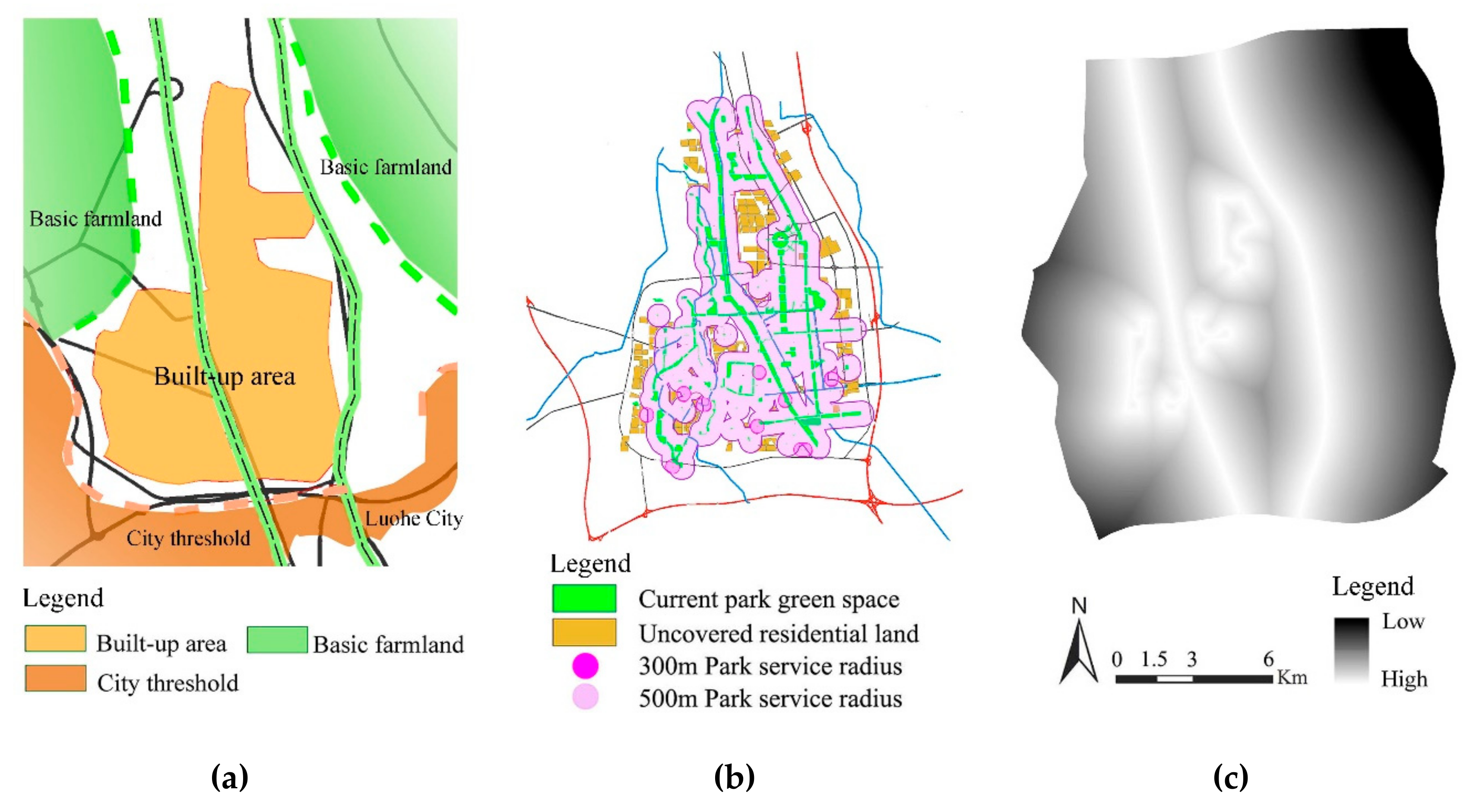
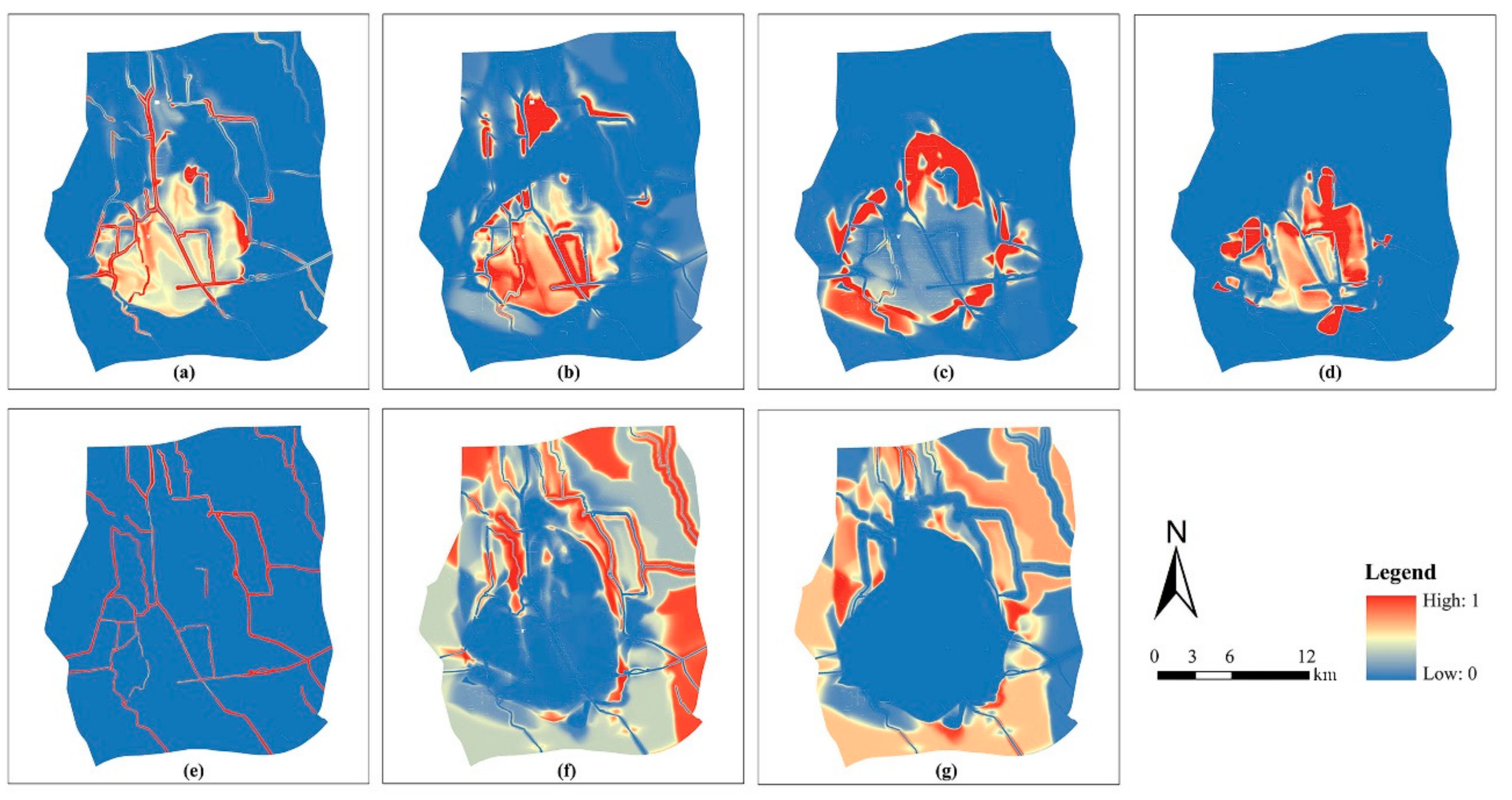
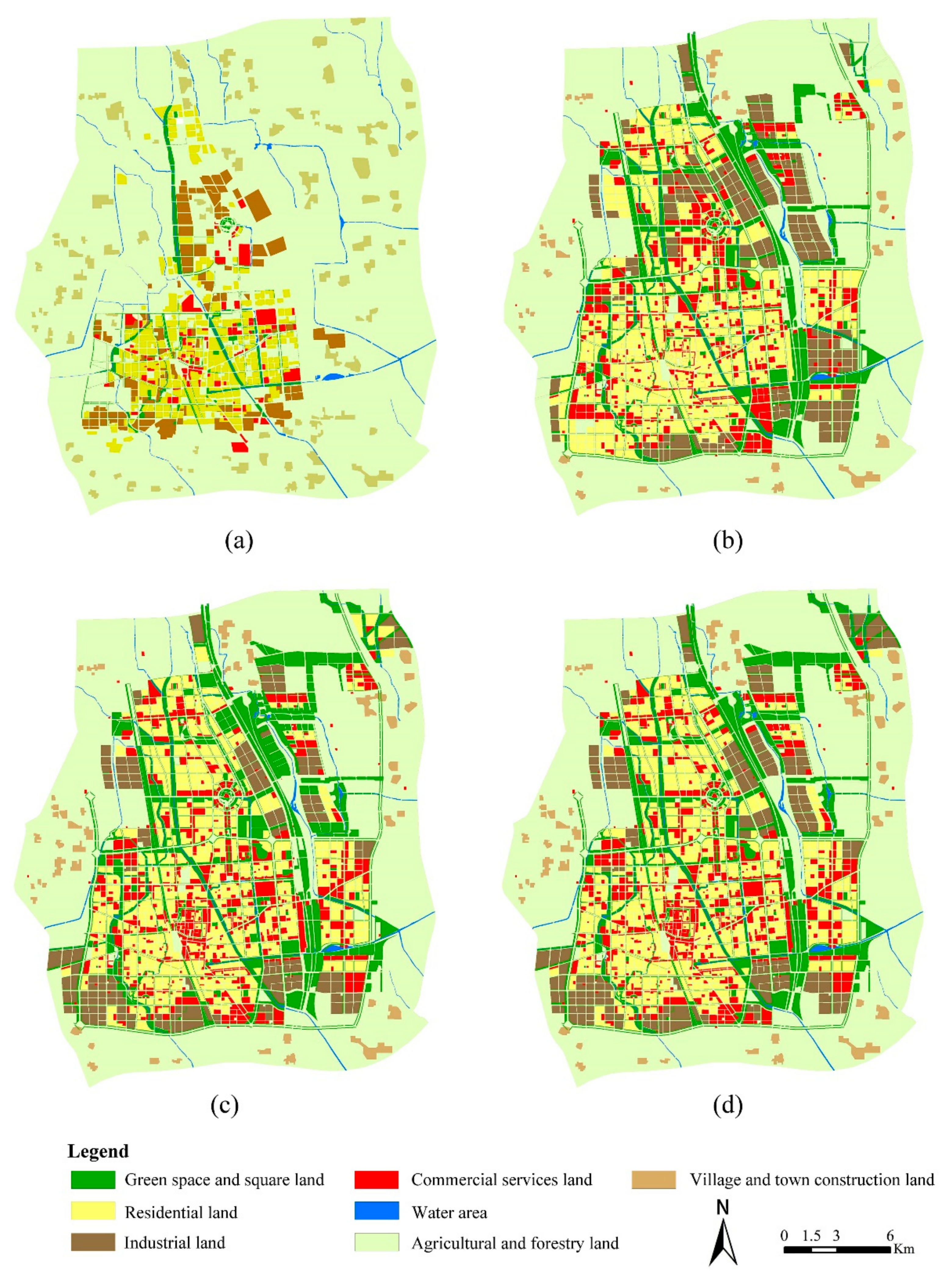
| Land Use Reclassification | Corresponding Urban Land Classification | Scope | ||
|---|---|---|---|---|
| Code | Category Name | Code | Category Name | |
| 1 | Green space and square land | G | Green space and square land | Land for urban public open space, such as park green space, protective green space, and square land |
| 2 | Residential land | R | Residential land | Land for housing and corresponding services |
| 3 | Industrial land | M | Industrial land | Land for production workshops, warehouses and auxiliary facilities of industrial and mining enterprises as well as land for material storage, transfer, and distribution |
| W | Logistics and warehouse land | |||
| 4 | Commercial services land | A | Logistics and warehouse land | Land for administration, culture, education, and other institutions and facilities; land for various commerce, business affairs, recreational and sports facilities; and land for supply, environment, safety, and other facilities |
| B | Commercial and service facilities land | |||
| U | Public facilities land | |||
| 5 | Water area | E1 | Water area | Rivers, lakes, reservoirs, potholes, and ditches, excluding park green space and water areas within the unit |
| 6 | Agricultural and forestry land | E2 | Agricultural and forestry land | Cultivated land, forest land, and other land |
| 7 | Village and town construction land | H14 | Urban and rural residential settlements construction land | Towns, villages, and independent construction land |
| Spatial Factors | The Distance to Center of Old City (b1) | The Distance to Center of Demonstration Area (b2) | The Distance to Highway (b3) | The Distance to Main Road (b4) | The Distance to Railway (b5) | The Distance to River (b6) |
|---|---|---|---|---|---|---|
| Regression coefficient | 2.622 | −1.237 | −0.721 | −2.007 | 3.132 | 2.018 |
| Land Use Classification | Land Area (hm2) | Proportion (%) | ||||||
|---|---|---|---|---|---|---|---|---|
| Code | Category Name | Status | Planning | Variation | Status | Planning | Variation | |
| H | Construction land | 13,122.71 | 20,308.09 | 7185.38 | 29.89 | 46.26 | +16.37 | |
| in (which) | Urban and rural residential construction land | 12,692.14 | 19,278.18 | 6586.04 | 28.91 | 43.91 | +15.00 | |
| Regional traffic facilities land | 326.20 | 599.69 | 273.49 | 0.74 | 1.37 | +0.63 | ||
| Regional utilities land | 28.41 | 323.38 | 294.97 | 0.06 | 0.74 | +0.68 | ||
| Special land | 75.96 | 106.84 | 30.88 | 0.17 | 0.24 | +0.07 | ||
| E | Non-construction land | 30,776.29 | 23,590.91 | −3590.91 | 70.11 | 53.74 | −16.37 | |
| in (which) | Water area | 520.46 | 565.64 | 45.18 | 1.19 | 1.29 | +0.10 | |
| Agriculture and forestry land | 30,255.83 | 23,025.27 | −3025.27 | 68.92 | 52.45 | −2.45 | ||
| Urban and rural land | 43,899.00 | 43,899.00 | — | 100 | 100 | — | ||
| Land Use Reclassification | Corresponding Land Use | Land Area (hm2) | Proportion of Urban Construction Land (%) | ||||||
|---|---|---|---|---|---|---|---|---|---|
| Code | Category Name | Code | Category Name | Status | Planning | Increment | Status | Planning | Variation |
| 1 | Green space and square land | G | green space and square land | 869.58 | 2469.53 | 1599.95 | 8.96 | 13.03 | +4.07 |
| 2 | Residential land | R | residential land | 3466.67 | 6463.31 | 2996.64 | 35.72 | 34.11 | −1.61 |
| 3 | Industrial land | M | industrial land | 2315.64 | 2552.13 | 236.49 | 23.86 | 13.47 | −10.39 |
| W | logistics and warehouse land | 75.70 | 791.50 | 715.8 | 0.78 | 4.18 | +3.40 | ||
| 4 | Commercial services land | A | public management and service land | 797.76 | 1485.50 | 687.74 | 8.22 | 7.84 | −0.38 |
| B | commercial and service facilities land | 487.20 | 2297.29 | 1810.09 | 5.02 | 12.12 | +7.10 | ||
| U | public facilities land | 144.61 | 220.87 | 76.26 | 1.49 | 1.17 | −0.32 | ||
| Construction Land Reclassification | Corresponding Urban Land Classification | Green Space Ratio Index | ||
|---|---|---|---|---|
| Code | Category Name | Code | Category Name | |
| 1 | Green space and square land | G | green space and square land | Green space ratio of square land is about 35% to 65% |
| 2 | Residential land | R | residential land | ≥ 30% |
| 3 | Industrial land | M | industrial land | ≥ 20% |
| W | logistics and warehouse land | |||
| 4 | Commercial services land | A | logistics and warehouse land | ≥ 30% to 35% |
| B | commercial and service facilities land | |||
| U | public facilities land | |||
| Land Use Demand | Green Space and Square Land | Residential Land | Industrial Land | Commercial Services Land | Water Area | Agricultural and Forestry Land | Village and Town Construction Land |
|---|---|---|---|---|---|---|---|
| Initial Pixel Number | 72,965 | 266,343 | 182,429 | 68,585 | 51,991 | 3,504,665 | 226,382 |
| Future Pixel Number | 411,554 | 640,723 | 326,228 | 362,465 | 51,991 | 2,505,443 | 91,448 |
| Land Use Demand | Residential Land | Commercial Services Land | Industrial Land | Green Space and Square Land | Water Area | Agricultural and Forestry Land | Village and Town Construction Land |
|---|---|---|---|---|---|---|---|
| Residential land | 1 | 1 | 0 | 1 | 0 | 0 | 0 |
| Commercial services land | 1 | 1 | 0 | 1 | 0 | 0 | 0 |
| Industrial land | 1 | 1 | 1 | 1 | 0 | 0 | 0 |
| Green space and square land | 0 | 0 | 0 | 1 | 0 | 0 | 0 |
| Water area | 0 | 0 | 0 | 0 | 1 | 0 | 0 |
| Agricultural and forestry land | 1 | 1 | 1 | 1 | 1 | 1 | 1 |
| Village and town construction land | 1 | 1 | 1 | 1 | 0 | 1 | 1 |
| Land Use Demand | Residential Land | Commercial Services Land | Industrial Land | Green Space and Square Land | Water Area | Agricultural and Forestry Land | Village and Town Construction Land |
|---|---|---|---|---|---|---|---|
| Weight of neighborhood | 1 | 0.7 | 0.6 | 0.7 | 0.2 | 0.5 | 1 |
| Scenarios | Land Use Type | ED | FRAC_MN | ENN_MN |
|---|---|---|---|---|
| Baseline Scenario | Green space and square land | 10.23 | 1.30 | 50.32 |
| Residential land | 8.95 | 1.03 | 40.33 | |
| Industrial land | 22.89 | 1.03 | 43.75 | |
| Commercial services land | 52.01 | 1.10 | 40.67 | |
| Agricultural and forestry land | 2.92 | 1.05 | 340.29 | |
| Planning Guidance Scenario | Green space and square land | 8.01 | 1.10 | 40.11 |
| Residential land | 7.21 | 1.02 | 41.98 | |
| Industrial land | 20.11 | 1.02 | 44.64 | |
| Commercial services land | 50.78 | 1.04 | 38.01 | |
| Agricultural and forestry land | 2.35 | 1.02 | 350.77 | |
| Master Plan Scenario | Green space and square land | 8.56 | 1.20 | 47.82 |
| Residential land | 7.25 | 1.02 | 42.65 | |
| Industrial land | 20.32 | 1.03 | 45.14 | |
| Commercial services land | 49.64 | 1.20 | 36.47 | |
| Agricultural and forestry land | 2.34 | 1.04 | 347.86 |
© 2019 by the authors. Licensee MDPI, Basel, Switzerland. This article is an open access article distributed under the terms and conditions of the Creative Commons Attribution (CC BY) license (http://creativecommons.org/licenses/by/4.0/).
Share and Cite
Liu, J.; Zhang, L.; Zhang, Q. The Development Simulation of Urban Green Space System Layout Based on the Land Use Scenario: A Case Study of Xuchang City, China. Sustainability 2020, 12, 326. https://doi.org/10.3390/su12010326
Liu J, Zhang L, Zhang Q. The Development Simulation of Urban Green Space System Layout Based on the Land Use Scenario: A Case Study of Xuchang City, China. Sustainability. 2020; 12(1):326. https://doi.org/10.3390/su12010326
Chicago/Turabian StyleLiu, Jie, Lang Zhang, and Qingping Zhang. 2020. "The Development Simulation of Urban Green Space System Layout Based on the Land Use Scenario: A Case Study of Xuchang City, China" Sustainability 12, no. 1: 326. https://doi.org/10.3390/su12010326
APA StyleLiu, J., Zhang, L., & Zhang, Q. (2020). The Development Simulation of Urban Green Space System Layout Based on the Land Use Scenario: A Case Study of Xuchang City, China. Sustainability, 12(1), 326. https://doi.org/10.3390/su12010326





